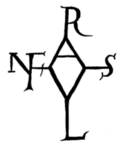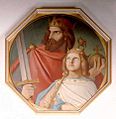Arnulf of Carinthia facts for kids
Quick facts for kids Arnulf of Carinthia |
|
|---|---|
| Emperor of the Romans | |

Seal of Arnulf of Carinthia c. 896
|
|
| Emperor in Italy | |
| Reign | 22 February 896 – 8 December 899 |
| Coronation | 22 February 896, Rome |
| Predecessor | Lambert |
| Successor | Louis the Blind |
| King of Italy | |
| Reign | 894 – 8 December 899 |
| Predecessor | Lambert |
| Successor | Louis the Blind |
| King of East Francia | |
| Reign | c. 27 November 887 – 8 December 899 |
| Predecessor | Charles the Fat |
| Successor | Louis the Child |
| Born | c. 850 |
| Died | 8 December 899 Ratisbon, Duchy of Bavaria, East Francia (now Regensburg, Bavaria, Germany) |
| Burial | St. Emmeram's Basilica, Ratisbon |
| Spouse | Ota Oda of West Francia Vinburge |
| Issue | Louis the Child Ratold of Italy Zwentibold Glismut of Carinthia Hedwig of Carinthia |
| House | Carolingian |
| Father | Carloman of Bavaria |
| Mother | Liutswind |
| signum manus (890) |  |
Arnulf (850 – December 8 899) was the Carolingian King of East Francia from 887 and Holy Roman Emperor from 896 to his death. He was the illegitimate son of Carloman, King of Bavaria, and his concubine, Liutswind, of Carantanian (Slovenian) origin, daughter of one Count Ernst. He was given the Duchy of Carinthia (a Frankish vassal state and successor of the ancient Principality of Karantania) by his father when he divided his realm, giving Bavaria to Louis the Younger and the Kingdom of Italy to Charles the Fat, in 880 on his death.
He spent his childhood in Karantania, homeland of his mother. Carloman had a court there, in Moosburg (then Blatograd), where the young Arnulf grew up. From later events it is evident that the Karantanians (mostly Slovenians), from an early time, treated him as their own Duke.
When, in 882, Engelschalk II rebelled against the margrave of Austria, Aribo, and ignited the so-called Wilhelminer War, Arnulf supported him and even accepted his and his brother's homage. This ruined Arnulf's relationship with his uncle the emperor and put him at war with Svatopluk of Moravia. Pannonia was invaded, but Arnulf refused to give up the young Wilhelminers. Arnulf did not make peace with Svatopluk until late 885, by which time the Moravian was a man of the emperor. Some scholars see this war as destroying Arnulf's hopes at succeeded Charles.
He took the leading role in the deposition of his uncle, the Emperor Charles the Fat. With the support of the nobles, Arnulf held a diet and deposed Charles in November 887, under threat of military action. Charles peacefully went into his involuntary retirement, but not without first chastising his nephew for his treachery and asking only for a few royal villas in Swabia, which Arnulf mercifully granted him, on which to live out his final months. Arnulf was elected by the nobles of the realm (only the eastern realm, though Charles had ruled the whole of the Frankish lands) and assumed his title of King.
Arnulf was not a negotiator, but a fighter. At the decisive Battle of Leuven in September 891, he defeated an invading force of the Northmen, or Vikings, essentially ending their invasions on that front. The Annales Fuldenses report that the bodies of dead Northmen blocked the run of the river. After his victory, Arnulf built a new castle on an island in the Dijle river.
In 893 or 894, Great Moravia probably lost a part of its territory — present-day Western Hungary — to him. Arnulf, however, failed to conquer the whole of Great Moravia when he attempted it in 892, 893, and 899. In 895, Bohemia broke away from Great Moravia and became his vassal. An accord was made between him and the Bohemian Duke Borivoj I (reigned 870-895); Bohemia was thus freed from the dangers of invasion.
In 893, Pope Formosus, not trusting the newly crowned co-emperors Guy and Lambert, sent an embassy to Regensburg to request Arnulf come and liberate Italy, where he would be crowned in Rome. Arnulf sent his son Zwentibold with a Bavarian army to join Berengar of Friuli. They defeated Guy, but were bought off and left in autumn. Arnulf then personally led an army across the Alps early in 894. He conquered all of the territory north of the Po, but went no further before Guy died suddenly in late autumn. Lambert and his mother Ageltrude travelled to Rome to receive papal confirmation of his imperial succession, but Formosus, still desiring to crown Arnulf, was imprisoned in Castel Sant'Angelo.
In September 895, a new embassy arrived in Regensburg beseeching Arnulf's aid. In October, Arnulf undertook his second campaign into Italy. He crossed the Alps quickly and took Pavia, but then he continued slowly, garnering support among the nobility of Tuscany. First Maginulf, Count of Milan, and then Walfred, Count of Pavia, joined him. Eventually even the Margrave Adalbert II abandoned Lambert. Finding Rome locked against him and held by Ageltrude, he had to take the city by force on 21 February 896, freeing the pope. Arnulf was there crowned King and Emperor by Formosus on 22 February. He only retained power in Italy as long as he was personally there. Arnulf marched on Spoleto, where Ageltrude had fled to join Lambert, but he suffered a stroke and had to call of the campaign. That same year, Formosus died, leaving Lambert once again in power. Rumours of the time made Arnulf's condition to be a result of poisoning at the hand of Ageltrude. He returned to Germany and had no more control in Italy for the rest of his life.
On Arnulf's death in 899, he was succeeded as a king of the East Franks by his son by his wife Ota († 903), Louis the Child. Arnulf's illegitimate son Zwentibold, whom he had made King of Lotharingia in 895, continued to rule there until the next year (900).
Images for kids
-
A charter of donation by king Arnulf of Carinthia, issued on 15 April 890 at Regensburg.
-
Arnulf of Carinthia and Louis the Child by Johann Jakob Jung (1840).
See also
 In Spanish: Arnulfo de Carintia para niños
In Spanish: Arnulfo de Carintia para niños




